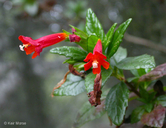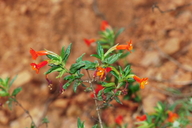Taxon Details
Diplacus parviflorus
island bush monkeyflower
View Report Copy Link Calflora eFlora CCH CalPhotos iNaturalist
Taxon Summary:
Diplacus parviflorus, commonly known as island bush monkeyflower, is a perennial evergreen shrub in the Phrymaceae that is found only in California. It occurs within Chaparral, Closed-cone coniferous forest, Coastal bluff scrub, and Coastal scrub, growing at elevations from 3 to 535 meters. Diplacus parviflorus is ranked 4.3, Plants of Limited Distribution, A Watch List; Not very threatened in California.|
Scientific Name: Diplacus parviflorus Greene |
||
|
Common Name: island bush monkeyflower |
||
| Family: | Phrymaceae | |
| Element Code: | PDSCR22030 | |
| USDA Plants Symbol: | DIPA10 | |
|
Synonyms/Other Names: |
||
| Name Status: |
JEF, FNA, POWO, IPNI, Tropicos |
|
| CA Rare Plant Rank: | 4.3 |
| Fed List: | None |
| State List: | None |
| Global Rank: | G4 |
|
State Rank: |
S4 |
| Other Status: | SB_CalBG/RSABG; SB_CRES |
|
CRPR Changes: |
|
| Add Date: | 1988-01-01 |
| Date Edited: | 2025-10-29 |
| Lifeform: perennial evergreen shrub | ||||||||||||||
Blooming Period: Mar-Oct
|
||||||||||||||
|
Elevation:
3 - 535 meters 10 - 1755 feet |
||||||||||||||
General Habitats:
|
||||||||||||||
| Microhabitat Details: | ||||||||||||||
Microhabitat:
|
||||||||||||||
| Threat List Total: | 0 | |
| Total EOs | % of EOs | |
| EOs with Threat Listed: | 0 | 0 % |
| THREAT LIST: | ||
|---|---|---|
| Total Occurrences: | 0 | ||||
| Element Occurrence Ranks: | |||||
|---|---|---|---|---|---|
| A | B | C | D | X | U |
| 0 | 0 | 0 | 0 | 0 | 0 |
| Occurrence Status: | |||||
|---|---|---|---|---|---|
| Historical >20 Years | 0 | ||||
| Recent <=20 Years | 0 | ||||
| Presence: | |||||
|---|---|---|---|---|---|
| Presumed Extant | 0 | ||||
| Possibly Extirpated | 0 | ||||
| Presumed Extirpated | 0 | ||||
| California Endemic: | |||||||||||||
| California Island: | |||||||||||||
|
States: Name (Code) California (CA) |
|||||||||||||
|
California Counties and Islands: Name (Code) Los Angeles (LAX), Santa Barbara (SBA), Ventura (VEN) |
|||||||||||||
|
Quads: Name (Quad Code) Anacapa Island (3311983), San Clemente Island Central (3211874), San Clemente Island North (3211885), San Clemente Island South (3211873), San Miguel Island East (3312083), Santa Cruz Island A (3311987), Santa Cruz Island B (3311986), Santa Cruz Island C (3311985), Santa Cruz Island D (3311984), Santa Rosa Island East (3311988), Santa Rosa Island North (3312081), Santa Rosa Island South (3312071), Santa Rosa Island West (3312082) |
|||||||||||||
Notes:
|
|||||||||||||
 Presumed Extant
Presumed Extant
Click on quad for name. Hold Shift Key to use mouse scroll wheel



